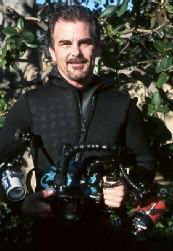 |
Cerbrilla sp.
Cerbrilla sp.photo courtesy of Garry McCarthy(Photographer) and Herb Gruenhagen(Finder)
La Jolla Shores
Cerberilla sp. 1 OR Cerberilla c.f. pungoarena Collier and Farmer 1964) ?
Over the past several years this Cerberilla has received increased attention as El Nino's warm waters have persuaded it to move northward along the California coastline into the Channel Islands. Shown as Species No. 217 in Pacific coast nudibranchs, it has been suggested that it may be identical to Cerberilla pungoarena described by Collier and Farmer in 1962. Farmer, more recently, pointed out an oversight in the original description in his posting on Cerberilla pungoarena to this web site. In this note he reports that the rhinophores are in fact smooth, as seen here. The body of this species is translucent, the cerata brown with with white tips. A thin branch of the liver diverticulum can be seen in many of the posterior cerata. A white line extends across the head and along the frontal edge of the long tapering cephala tentacles and foot corners.
As more specimens have been collected, and photos taken, no differences have jumped out to distinguish the two. It seems reasonable that this sand dwelling aeolid, now common in San Diego and the California Channel Islands is in fact C. pungoarena from Mexican waters. By the International Rules of Zoological Nomenclature however, formal taxonomic revision can only be done in accordance to the Rules. My suggestion here, cannot be considered a formal name change or assignment, but only a suggestion for current vernacular usage.
This species has become common from the shallow surf zone to 44 feet of water on a sand and shale bottom. Recent sightings include Near Scripps Institution in La Jolla, by your webmaster and colleagues, and Anacapa Island, California (Kathy Olson-deWet and Jack Engle, pers. comm.). Cerberilla pungoarena Collier & Farmer 1964, described originally described from Puerto Refugio, Isla Angel de al Guardia in the Gulf of California.
I have been in love with the sea for as long as I can remember, having made my parents purchase the entire Undersea World of Jacques Cousteau book set when I was about 7. I learned to scuba dive at age 15, and have spent many years diving off of Southern California, with occasional trips to warmer waters. One of my biggest frustrations, however, was my inability to convey to friends and family my experiences while diving, especially the beautiful and unusual sights below the surface.

|
My first exposure to underwater photography occurred when I borrowed a friend's point-and-shoot camera. I enjoyed it so much, I immediately started looking for my own setup. While at a photo swap-meet, I found a used Ikelite housing, which was made for an unknown camera, for next to nothing. I stuffed my Canon AE-1 into what turned out to be a Nikon F3 housing, bent a few control rods to make it work, bought the least expensive strobe I could find, and was off to Cozumel. Some of the first shots I took include the brittle star, the spotted moray and the juvenile octopus. I am currently serving as president of the San Diego Underwater Photographic Society , a great organization whose, members range from beginners to some of the most experienced professional underwater photographers in the world. Membership in this group has allowed me the opportunity to not only grow as a photographer -- benefitting from the years of experience among the other members -- but to make many new friends and dive buddies as well.
I live in San Diego, California and dive often in the cool waters offshore. My wife, Tammy, prefers diving
in warm, clear and calm waters. Our children, Patrick (9) and Kelsey (11) both share our love of the
ocean, and have snorkeled with turtles in Hawaii and sharks in California. They cannot wait to learn to
dive so they can see the critters up close. We cannot wait to share it with them. |
San Diego, Oct. 1999
Webmasters Note: Garry has his own webpage at Underwater Images which is wll worth a visit for its stunning images and informative marine biology asides accompanying the photos !
Taxonomic information courtesy of:

David W. Behrens
Author:
Pacific Coast Nudibranchs
Send Dave mail at seachalleng@earthlink.net
|
